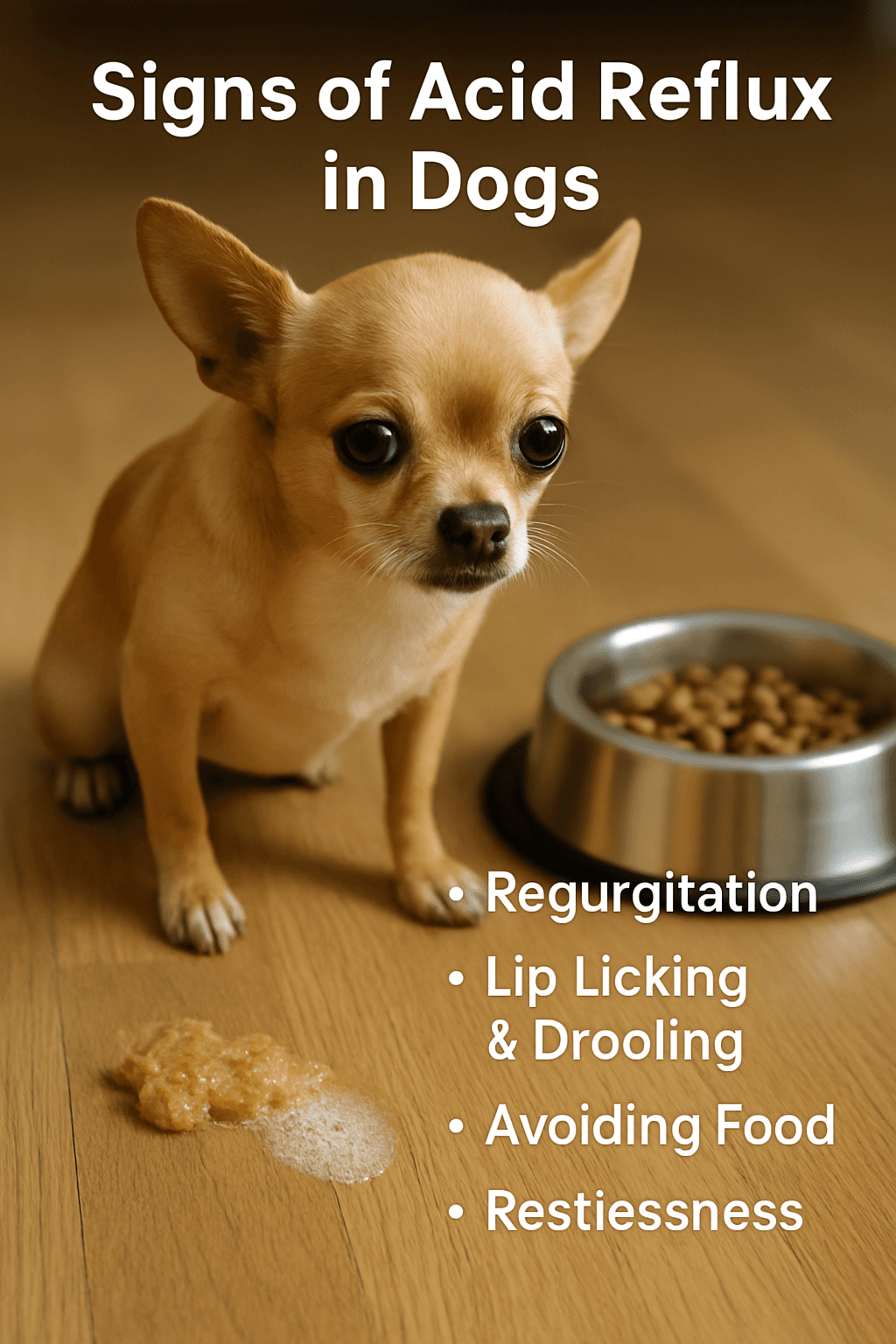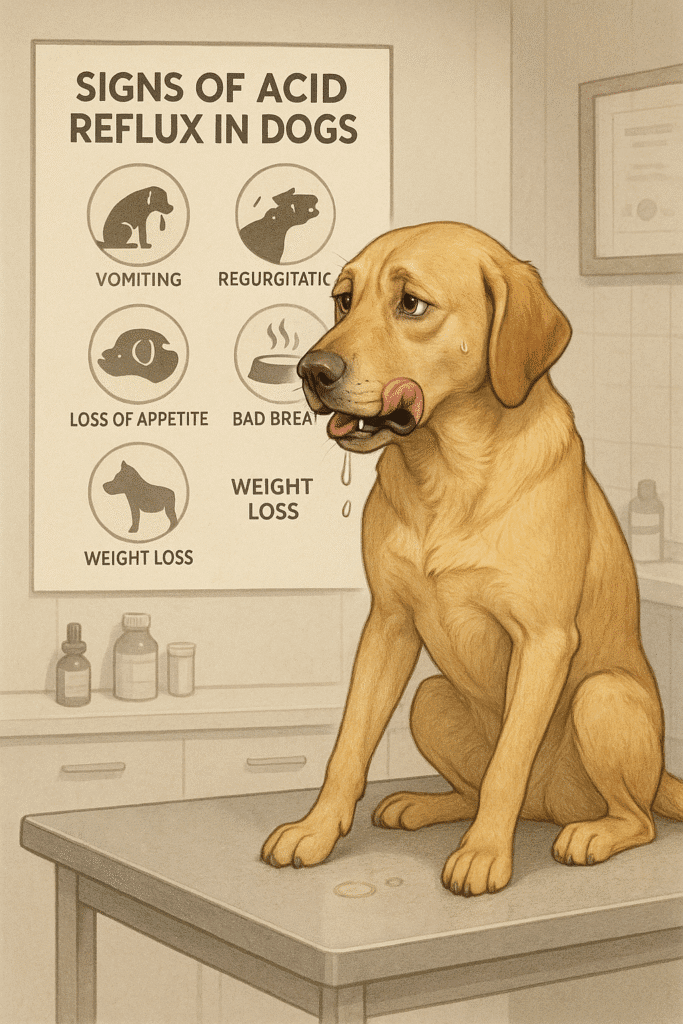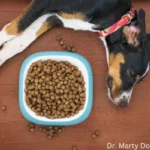Signs of Acid Reflux in Dogs

Stomach troubles in pets can be tricky to spot—particularly when your furry pal can’t describe what feels off. When a companion begins gagging after meals, acting restless, or showing less excitement toward food, it might point to something deeper happening inside that isn’t obvious right away. This issue often slips by unnoticed, yet it shows up more often than many assume, creating genuine unease for that loyal four-legged friend.
This guide takes a closer look at what such troubles may look like. You’ll learn how to recognize early warning signs, uncover possible reasons behind them, understand how experts identify what’s happening, and explore practical ways to manage things effectively. Once you’ve gone through it, you’ll have a clearer sense of what to observe and how to make daily life more comfortable for your companion.
What Is Acid Reflux in Dogs?
When food or fluid from the stomach drifts upward into that passage linking mouth and stomach, irritation and burning sensations often follow. A small circular muscle normally seals tightly once eating ends, keeping contents where they belong. When that muscle weakens or doesn’t close completely, acidic material and partially digested matter slide upward, creating sharp internal discomfort and a sense of unease.
For a furry companion, this situation might appear through subtle signs such as mild restlessness after eating, gulping, or occasional regurgitation. If left unchecked, those signs can grow into more persistent troubles that affect appetite, mood, and overall comfort.
What Might Be Causing It?
No single cause always explains what’s happening. Often, several elements come together—diet choices, internal mechanics, or certain prescribed substances. Here’s a closer look at some frequent contributors:
Reactions After Surgery
After anesthesia, digestive rhythm may take a while to return to normal pace. Sedative agents tend to relax muscles responsible for keeping food and liquid contained, including a small valve that blocks upward flow from stomach to throat. With that relaxation, acid and partially digested material can slip in unintended directions, creating irritation or mild reflux sensations. Such unease often shows up a few days after a procedure, gradually fading as internal motion steadies and natural balance restores itself.
Overeating or Picking Unsuitable Foods
Sometimes a pup dives into something greasy or overly rich—or maybe portions just got a little too generous. Either situation can bog down internal movement, forcing things to linger longer than intended. That delay often triggers queasy sensations or sudden regurgitation, especially when digestion can’t keep up with what was taken in.
An Internal Change
At times, part of stomach tissue can slip upward into chest space through a small opening in diaphragm. Once this shift occurs, pressure rises where it shouldn’t, throwing off normal digestive rhythm. Food and fluids may drift in unwanted directions, causing burning, tightness, or queasy sensations around chest area. Though uncommon, this situation can bring sudden discomfort and make it harder for digestion to stay on track until balance returns.
Carrying Extra Weight
Extra weight doesn’t only change appearance; it can also push inward on stomach walls from outside. That added force increases chances of acid and food shifting upward instead of staying in place. Pressure from surrounding tissue can gradually make digestion less efficient and more prone to irritation. Maintaining steady habits, balanced meals, and regular movement can ease strain and keep internal flow running smoothly.
What Goes into That Bowl
If their bowl is packed with cheap fillers, artificial additives, or ingredients they’re sensitive to, their system may not handle it well. Instead of processing everything smoothly, things can get backed up or act out of rhythm. This can lead to a sluggish process, making them feel off or unsettled, especially if it keeps happening over time.
Medication Reactions
Certain prescriptions, especially ones meant to ease discomfort or calm swelling, can turn rough on digestive pathways. Though such treatments serve vital purposes, they may irritate delicate surfaces or interrupt normal movement of meals and liquids. When a new dosage brings queasy sensations, frequent burping, or sluggish digestion, catching those early signs can prevent deeper troubles later on.
Common Symptoms of Acid Reflux in Dogs
Not every sign shows up clearly when something’s bothering them internally. Some cues can be subtle, while others are harder to ignore. If you’ve got a furry friend that’s been acting a little strange around food or right after a meal, here are some red flags to keep an eye on:
Brings Food Back Up Without Warning
At certain moments, a furry companion may suddenly bring up recently swallowed kibble or water soon after finishing a meal. What makes this event stand out is how quietly it occurs—no gagging sounds, no visible strain, no early signs of distress. Contents seem to slide upward and spill out almost effortlessly, leaving no time to react. Rather than a loud, messy scene that often signals sickness, this version arrives in near silence, surprising anyone nearby and hinting that something within isn’t working quite as it should.
Constant Licking or Drool That Won’t Quit
When an odd feeling develops inside mouth or throat, repeated lip-licking or licking at empty air may start showing up. That motion isn’t random—it’s often a reaction to discomfort or a lingering tickle that feels unfamiliar. When extra drool joins in, it usually points to irritation or reflux stirring beneath the surface. Those small, instinctive actions act as quiet indicators that internal balance isn’t sitting quite right.
That Gag or Hack, Especially After Sips or Bites
You might notice a coarse cough, a dry gagging motion, or that repeated hacking sound showing up again and again, often right after sipping water or resting post-snack. Such reactions usually happen when fluid or food remnants shift upward instead of moving along their normal path, or when small traces remain stuck in sensitive areas. That response acts as a natural effort to clear things out and restore smooth passage, signaling that digestion might be under strain.
That Yellow Stuff on the Floor? Yeah, That’s a Sign
Finding a patch of yellow, bubbly liquid after some quiet time between meals can point to more than a random upset. That strange-looking puddle often appears when stomach acids build up without much food to work on, leading to irritation inside. It’s a sign that digestive flow may be out of rhythm or that long gaps between meals are stirring up discomfort. Rather than writing it off as a fluke, taking note of when it happens can reveal patterns and help identify what’s setting off that reaction.
Loses Interest in Mealtime
That bright spark—ears perked, tail in motion, eager eyes locked on dinner—can fade fast once inner unease sets in. When that lively energy turns into cautious sniffing or quiet retreat from a bowl, it often hints at something deeper going on. A pup once diving into meals but now hesitating or skipping them altogether might be wrestling with irritation along inner passages or unsettled digestion. Paying close attention to when those shifts appear can reveal patterns and point toward what’s stirring discomfort, giving a clearer path toward easing future mealtimes.
Noticeably Slimmer Than Usual
When turning away from meals starts happening often, or when digestion slows down and nutrients aren’t being absorbed properly, gradual weight loss can appear almost unnoticed at first. Over time, shape begins to change—ribs stand out more clearly, and padding around sides or spine starts thinning. This shift usually signals more than picky eating; it often indicates deeper imbalance within internal systems that needs attention before it worsens.
Acting Strange After Mealtime
If they begin roaming aimlessly around the room, let out soft whimpers, or appear oddly unsettled or gloomy after having their usual bites, it’s worth paying attention. They can’t speak up to explain what’s bothering them, but their actions often reveal what words can’t. Noticing this kind of uneasy behavior right after they’ve had something to chew on could be your first clue that something didn’t settle quite right internally.

Less Obvious (But Still Important) Red Flags
Not every concern shows clear signs at first. Often, it’s slight behavioral shifts—a drop in usual energy, new patterns that don’t fit, or reactions that seem out of place—that signal something is off balance. Those understated cues can carry more meaning than dramatic symptoms, offering early insight that internal processes aren’t running smoothly and may require a closer look before they grow into bigger troubles.
Persistent Bad Breath
When harsh internal fluids rise upward, they release a sharp, lingering scent that settles around mouth area. That sour or metallic trace often remains even after plenty of chewing or attempts to freshen breath with dental treats. Such an odor usually signals deeper imbalance within, something that cannot be masked or managed through surface-level fixes. It acts as an early sign that inner functions aren’t working in proper rhythm and need careful attention before things progress further.
Munching on Grass
At times, they may head straight for a patch of grass and begin chewing without hesitation. That behavior often stems from an instinctive drive to ease internal discomfort or to trigger a natural purge when something unpleasant lingers inside. Grass acts as a simple, familiar way for them to respond to irritation, signaling that digestion might be unsettled or that they’re trying to clear out what doesn’t belong.
Doesn’t Want to Lie Down
After finishing their bowl, your furry companion might seem uneasy about settling down. Instead of curling up for a nap like usual, they may remain seated or stand in place, avoiding the typical sprawled-out position. This hesitation often stems from a sense that staying upright brings a bit of relief, especially if lying flat makes things feel worse internally.
Loud Gurgles and Odd Noises
You might start hearing odd internal noises—like low gurgling, unexpected burps, or deep rumbling—that weren’t common before. These unusual sounds often hint that something inside isn’t quite settling right and may be struggling to function smoothly. If these noises become frequent or occur during quiet moments of rest, it’s worth paying attention—they could be your furry companion’s way of signaling that something needs a closer look.
Frequent Swallowing or Throat Movements
If you notice your four-legged buddy frequently swallowing or making small throat-clearing movements, it could mean something deeper is bothering them. These repetitive actions are often their way of trying to soothe an uneasy sensation in their throat or chest area. Instead of ignoring it as a quirky habit, it’s worth keeping tabs on—especially if it happens after they’ve had something to drink or been near their bowl. Subtle behaviors like this can be their way of showing that something just isn’t sitting quite right inside.
Breeds That May Be More Prone
While any four-legged companion can experience issues related to internal imbalance, certain breeds are more likely to face these challenges because of their physical structure or specific inherited conditions.
- Flat-faced breeds such as Bulldogs, Pugs, and Boxers often face issues because of how their bodies are built. Their compact snouts can make breathing a bit more labor-intensive, which increases internal strain, especially around the belly region. This added internal pressure can affect how everything functions internally, especially when there’s a shift in posture or after consuming anything. Because of this combination of structural limitations and internal tension, they’re more likely to experience challenges related to how things move through their system.
Tiny companions, like toy-sized breeds, often react more strongly to certain ingredients due to their petite build and heightened sensitivity. Their internal systems can be easily overwhelmed, making them more prone to challenges when processing what goes into their bowls. Even minor changes in what they consume can lead to noticeable shifts in behavior or appetite, requiring closer attention to what’s offered during the day.
Larger companions such as Great Danes and German Shepherds are more likely to face internal pressure-related challenges, like bloat, which can lead to backward movement of internal contents into areas they don’t belong.
How Vets Diagnose Canine Acid Reflux
Hands-On Check
First comes a thorough physical review. A veterinarian typically feels around abdominal areas, listens closely for unusual gurgles or tension, and gathers details about recent meals, energy levels, and daily habits. Those early observations offer valuable insight into what might be stirring discomfort or throwing digestion off rhythm.
A Closer Look Inside
This approach serves as a reliable way to get a direct look inside. A small camera moves through upper digestive passages, allowing close inspection of surfaces for redness, swelling, or hidden trouble spots. That visual check helps reveal what might be causing discomfort or slowing digestion, giving a clearer picture of what’s really happening within those inner pathways.
Imaging Tools
X-rays or ultrasound imaging provide a deeper look inside to identify what might be interfering with smooth digestion. These scans can reveal hidden blockages, unusual masses, or misplaced structures that disrupt normal flow. By capturing those internal details, they make it easier to understand whether mechanical issues or underlying conditions are behind ongoing discomfort.
Measuring Acidity
In some cases, they’ll want to monitor acid levels directly to confirm what’s going on. It’s a more advanced option but sometimes necessary when other methods aren’t conclusive.
Treatment Options
Here comes encouraging news—many situations can be handled quite well when recognized and addressed early. With timely attention and steady adjustments, discomfort often fades, allowing normal digestion and energy to return without lasting trouble.
Medications:
Several prescribed treatments can ease discomfort and restore smoother internal flow. These formulations work by lowering excess acid, improving movement of food and fluids through digestive passages, and shielding delicate inner linings from irritation. By steadying internal activity and encouraging natural rhythm, such approaches often bring noticeable comfort and stability, particularly when guided by a trained professional who tailors each step to individual needs.
Acid-reducing medicines (such as famotidine or omeprazole): These regulate how much acid forms within internal passages, creating a calmer setting inside. By easing that sharp internal burn, discomfort lessens and chances of repeated signs—like coughing, throat clearing, or frequent swallowing—begin to fade.
Motility boosters, like metoclopramide, work to keep internal movement consistent and well-timed. By encouraging quicker passage of food and liquid through digestive pathways, these medications reduce chances of backward flow or lingering material. Faster, more coordinated motion can ease strain and bring noticeable relief, particularly when discomfort tends to appear after eating or drinking.
Protective agents (like sucralfate): Coating agents like sucralfate create a gentle protective layer across inner throat surfaces. That thin film acts as a buffer, keeping fragile tissue safe from acidic or irritating material that might otherwise cause more damage. By limiting direct contact and giving sensitive areas time to recover, this approach encourages smoother healing and reduces recurring irritation during digestion.
Important: Always speak with a qualified animal professional before offering anything that’s typically used by people. What may seem harmless for you can sometimes lead to serious issues for your four-legged companion.
Surgical Correction:
When trouble arises from a structural flaw such as a hernia close to diaphragm or when tissue injury extends deeper than surface layers, surgical correction often becomes most reliable path forward. A qualified specialist studies each situation closely, detailing available choices and describing what recovery may look like afterward. That careful direction allows each decision to match specific condition and promotes steady comfort once restoration reaches its end.
Diet and Routine Tweaks That Can Make a Big Difference
Adjusting a few daily habits at home can really improve your companion’s well-being and help steer clear of those belly troubles altogether.
Offer Smaller Portions More Often
Splitting daily meals into several smaller portions can greatly reduce strain on digestion. Rather than serving one or two heavy feedings, providing a few lighter ones allows food to move through internal pathways more smoothly and with less pressure. This steady pacing minimizes chances of material backing up or lingering too long in one place. Such a small adjustment often brings visible comfort, keeping mealtimes calm and digestion steady from start to finish.
Raise the Food Bowl a Bit
Lifting a feeding bowl a few inches from ground level can noticeably improve how food moves through internal passages. For pets that eat quickly or have short necks and wide chests, this small change lets gravity guide each swallow downward with smoother flow. An elevated setup eases strain on neck and chest areas while keeping food from lingering too long or drifting in reverse. Even such a modest adjustment can bring calmer digestion, less discomfort, and a more relaxed experience after every meal.
Stick to Gentle, Low-Fat Options
Select gentle, uncomplicated meals that keep digestion steady and easy. Using clean, high-quality ingredients without heavy fillers, grease, or synthetic additives allows internal flow to stay smooth and consistent. When nourishment comes from simple, natural sources, inner rhythm stays calm, energy remains steady, and overall comfort improves for any furry companion trying to stay in good shape.
Keep Them Upright After Meals
Once they’ve finished their bowl, encourage a calm, light stroll or simply have them remain upright for 15 to 20 minutes. Keeping them on their paws during this time allows everything to move along more smoothly internally and reduces the chances of anything backing up or causing unease. Avoiding immediate rest after mealtime can make a big difference in how well their body handles what they’ve just consumed.
Skip Late-Night Snacks
Feeding a large portion close to bedtime can cause unnecessary strain once rest begins. When stomach space fills up and lying down follows soon after, internal pressure rises and natural flow slows. That horizontal position makes digestion work harder, often leading to mild agitation, uneasy sleep, or discomfort through nighttime hours. Offering lighter portions earlier in the evening keeps things moving smoothly and promotes calmer rest later on.
Keep an Eye Out for Trigger Foods
At certain times, what lands in a food bowl may not blend well internally. Subtle shifts begin to appear—turning away from meals, pacing once eating ends, or seeming unusually uneasy for no clear reason. When that pattern shows up, ingredients in daily feedings might be stirring irritation or sensitivity. Switching to simpler blends that avoid common triggers such as chicken, beef, or grains can bring smoother digestion and steadier comfort. Limited-ingredient recipes often keep things clean and gentle, allowing natural balance to return without strain.
When It’s Time to Get Emergency Help
Even though that nagging stomach issue might seem manageable at first, there are moments when things go from “it’s fine” to “we need to act fast.” If that four-legged family member starts showing any of the following red flags, don’t wait around—call your local emergency clinic or primary care provider right away.
Red Flags That Shouldn’t Be Ignored:
Keeps bringing stuff back up repeatedly: When a furry companion continues bringing up material for more than a full day—and that effort carries on even after stomach contents are gone—it signals a deeper concern. Such repeated motions without results rarely stem from simple irritation or routine upset. Persistent empty retching or frequent vomiting points to internal distress that requires prompt evaluation. Waiting too long can allow underlying problems to worsen, so quick action becomes essential once this pattern appears.
Presence of Blood:
If you notice anything with a reddish tint or dark specks that resemble ground coffee in what your furry companion expels, it’s a serious red flag. This kind of appearance often hints at internal distress that needs to be evaluated urgently by a professional. Don’t wait—reach out to a clinic right away if this shows up.
Having Trouble Catching Their Breath or Gasping for Air:
When it looks like your four-legged buddy is working extra hard just to inhale—or if they suddenly act like something’s stuck in their throat but there’s nothing there—it’s a red flag. Labored breathing, wheezing, or panicked gulping motions should never be brushed off. This kind of struggle could point to something serious going on inside, and it calls for immediate attention from a professional.
Rapid drop in body mass or complete lack of energy: If it seems like they’re shrinking noticeably within a short time or struggling just to lift themselves off the ground, that’s a red flag worth addressing immediately.
Sudden Collapse or Loss of Consciousness:
When a furry companion suddenly stumbles, goes slack, or shows disorientation before collapsing, it marks a critical situation. Such episodes can strike without any hint beforehand, lasting only moments or stretching longer depending on severity. Eyes may glaze, movements may freeze, or awareness may fade entirely for a brief span. These incidents often signal serious internal malfunction—possibly involving circulation, nerve activity, or disrupted organ function. Quick professional intervention becomes vital once such symptoms appear, as swift action can determine how well recovery unfolds afterward.
In any of these cases, don’t try to wait it out or “see if it passes.” Get on the phone and speak to a professional immediately. It’s always better to be safe than sorry—especially when your companion can’t speak for themselves.
Long-Term Outlook and What to Expect
When this issue is caught early and managed consistently, most companions bounce back well and go on living comfortably. For many, it’s a matter of monitoring and staying on top of things with proper care. But if ignored or left unchecked over time, the condition may begin to take a toll in deeper ways.
Certain companions may experience inflammation within the passage that carries food downward, creating sharp discomfort whenever eating begins. In more advanced situations, that same channel can tighten, slowing movement and making each swallow more difficult. Another concern arises when acidic material drifts upward and slips into airways, triggering coughing or breathing distress. With time, limited intake or constant irritation can interfere with proper nourishment, causing gradual weight loss and lack of essential nutrients needed for steady strength and vitality.
Quick response at first sign of unease holds real importance. Staying watchful for changes in appetite, mood, or daily rhythm allows early correction before lasting harm develops. Regular evaluations and mindful adjustments keep internal systems running smoothly, reducing strain and promoting steady comfort. Acting promptly preserves strength, balance, and overall ease, giving a companion greater chance for long, content living.
Conclusion
Acid reflux in dogs often goes unnoticed at first, even when small clues begin to appear. Many pet parents overlook it, thinking their pup is just having an off day. Yet this condition shows up more often than expected. Early hints—such as gentle gagging, frequent lip-licking, or bringing food back up shortly after eating—can signal that acid is moving where it shouldn’t. Spotting those details early and teaming up with a trusted professional to create a treatment approach can make recovery smoother and comfort return faster.
Whether it’s a change in food, a medication tweak, or just feeding in smaller portions, small adjustments can have a huge impact. Your dog deserves to live pain-free and happy—and with a little attention, you can help make that happen.
Frequently Asked Questions (FAQs)
Q: Can this issue go away without medical help?
When discomfort shows up in a mild way, slight adjustments to what fills that food dish can often calm things down. Swapping out ingredients, changing meal timing, or offering smaller portions may reduce strain and ease irritation. Yet when signs continue or grow stronger, guidance from an experienced specialist becomes essential. Focusing only on surface signs may bring short-term ease, but tracing what’s stirring the trouble deep inside is what brings lasting comfort and steady recovery for that furry companion.
Q: Does this condition cause discomfort?
Exactly. Once that inner lining turns irritated or forms tender spots, noticeable discomfort often follows. Many pups begin turning away from meals, circling restlessly after eating, or showing odd reactions that stand out from their regular patterns. Such moments usually signal internal unease that shouldn’t be ignored, especially when behavior shifts appear suddenly.
Q: Can younger ones experience this too?
Exactly right. Such occurrences are entirely possible, particularly among younger pups. Many times, it shows up in those born with internal formations that don’t function as intended—such as a small flap staying partially open when it should shut completely. In other cases, some pups naturally possess higher sensitivity within their digestive pathways, causing them to react intensely to triggers that might not affect others in any noticeable way.
Q: Are there any home-based options to help?
Some pet owners have experimented with natural options such as slippery elm, probiotics, or a small dose of aloe vera juice—provided it’s the type specifically formulated for animal use. However, it’s always wise to speak with a qualified expert before introducing anything unfamiliar into their routine.
Q: How quickly can things start looking better once treatment begins?
With careful direction that includes customized feeding adjustments and any advised remedies, changes often start showing within a short stretch of days. Many pups regain their comfort, energy, and appetite surprisingly fast once their system begins settling into a routine that fits their individual needs.



